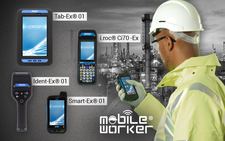Real-time integration of people, processes and systems will shape the industries of the future, enabling higher operational efficiencies at reduced cost. Even today, the use of digital tools such as smartphones and tablets are improving safety, productivity and security in hazardous areas. Companies who deploy these digital tools benefit from more efficient workflows, effective maintenance and streamlined decision-making processes as well as higher profit margins.
As the Industrial Internet of Things gathers pace, wirelessly connected data loggers, portable gas detectors, and personal health monitors are becoming available. ecom's Mobile Worker platform wirelessly integrates these devices with the digital tools, delivering a step change in flexibility and future-proofing. It provides a solid foundation to build on, with an unmatched choice of products proven to work wirelessly together to maximize workforce productivity and protection - essential elements for the prolonged future sustainability of companies with hazardous areas.
Transparent, complex processes and high data accuracy requires digital solutions
Many industrial companies today continue to use yesterday's technologies to plan, execute, manage and control their business processes. Due to a lack of alternatives or purely out of habit ("we've always done it this way"), many tasks are still performed with clipboard and paper. These archaic methods bring increased risk and inflexibility to the business, being error-prone and inefficient. They also lead to mobile workers carrying more than they should when walking around the site, creating a potential safety issue.
The world's first 4G / LTE Android Tablet, the Tab-Ex® 01, and the 4G / LTE Android Smartphone, the Smart-Ex® 01, for use in Zone 1/21 and Division 1, open up the advantages of the Internet of Things. They modernize data capture and simplify voice/video collaboration between the mobile workforce and the experts at the control centre. The devices also enable real-time access to digital work order documents, permits and drawings whilst supporting a range of wirelessly connected devices - reducing what the mobile worker has to carry and reducing the overall investment cost.
Benefits of professional applications and innovative hardware
For the first time, digital tools have the performance necessary to run a variety of professional software applications, providing the platform to create new solutions to meet the increasing challenges in hazardous areas. One such application is ecom's CamScan Keyboard app. This app allows - even offline - barcodes (1D, 2D and QR codes) to be scanned and processed by simply using the camera of a smartphone or tablet. By minimizing the use of free-hand text, operators begin to record more consistent data, enabling easier manual or even automated analysis and reducing the risk of human error. Thus, incorrect input and poorly transcribed records can be avoided entirely.
When scanning barcodes, some use cases require repetitive scanning (200+ scans per hour), long range scanning (up to 15 meters), or need to scan challenging barcodes. For these use cases, ecom offers innovative hardware based solutions like the Ident-Ex® 01 and i.roc® Ci70-Ex. Ident-Ex® 01 is a powerful, intrinsically safe Bluetooth "All-in-One" barcode scanner and RFID reader. i.roc® Ci70-Ex is the first intrinsically safe PDA with WWAN, each with changeable head modules (RFID, 1D / 2D barcode or combined head modules) for customer specific configuration.
Overcoming challenges with mobile devices
Many challenges in hazardous areas can be solved with the use of these digital tools. Accurate and timely information regarding the position and condition of mobile workers, equipment and material are critical for all companies, enabling predictive maintenance, the safe storage and transport of sensitive goods, and better visibility and control to prevent unplanned downtime and safety incidents.
In conjunction with a smartphone, tablet or handheld computer designed for use in hazardous areas, the mobile worker can retrieve current information about the status of machines or their parts on the screen of their device. He communicates in real time with the specialist staff located at the control centre, reports any damage, retrieves information on demand and receives guidance. Any data updates made in the field are transferred directly into the company systems, allowing quicker decision-making and reduced unplanned downtime.
Furthermore, the technicians are much better protected on site by the permanent connection to the control centre. Lone worker protection systems can warn the control centre automatically when a worker has an accident or can notify and warn the worker of any hazards as they move into an area.
